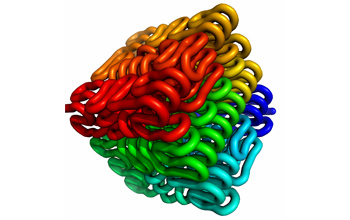Multimedia Gallery
Long stretches of DNA fold into Peano curve-like structures in human genome
In 1890, Giuseppe Peano discovered the Peano curve, one-dimensional curves that densely fill higher-dimensional spaces. Three-dimensional mapping of the human genome suggests that long stretches of DNA fold into Peano curve-like structures like the one pictured here.
[Research supported in part by a U.S. National Science Foundation Graduate Research Fellowship.]
Learn more in the Harvard Gazette story Scientists have deciphered 3D structure of the human genome. (Date of Image: 2009)
Credit: Leonid A. Mirny and Erez Lieberman-Aiden
Images and other media in the National Science Foundation Multimedia Gallery are available for use in print and electronic material by NSF employees, members of the media, university staff, teachers and the general public. All media in the gallery are intended for personal, educational and nonprofit/non-commercial use only.
Images credited to the National Science Foundation, a federal agency, are in the public domain. The images were created by employees of the United States Government as part of their official duties or prepared by contractors as "works for hire" for NSF. You may freely use NSF-credited images and, at your discretion, credit NSF with a "Courtesy: National Science Foundation" notation.
Additional information about general usage can be found in Conditions.
Also Available:
Download the high-resolution JPG version of the image. (782 KB)
Use your mouse to right-click (Mac users may need to Ctrl-click) the link above and choose the option that will save the file or target to your computer.



 All images in this series
All images in this series